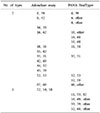Abstract
Background
The PANA RealTyper HPV kit (PANAGENE, Korea; PANA RealTyper) was developed to genotype human papillomavirus (HPV) and was based on multiplex real-time PCR amplification and melting curve analysis. In this study, we compared PANA RealTyper to the AdvanSure HPV GenoBlot assay (LG Life Sciences, Korea; AdvanSure assay) and attempted to evaluate the performance of PANA RealTyper.
Methods
A total of 60 cervical specimens were collected from women undergoing routine cervical cancer screening. The AdvanSure assay and PANA RealTyper kit identified the same 20 high-risk genotypes. However, the AdvanSure assay identified 15 low-risk genotypes, while the PANA RealTyper kit identified only 2 but detected 18 low-risk genotypes.
Results
Among the total 60 specimens, 54 high-risk genotypes (40 specimens) and 20 low-risk genotypes (18 specimens) were detected. The agreement rates of the assays ranged from 94.4 to 100% for high-risk genotypes. Among 9 genotypes that were positive in the PANA RealTyper kit but negative in the AdvanSure assay, 7 were confirmed as true positive (HPV genotypes 16 (n=1), 39 (n=1), 52 (n=1), 58 (n=2), 68 (n=2)). Among 4 genotypes that were negative in the PANA RealTyper kit but positive in the AdvanSure assay, 3 were confirmed as HPV genotype 59. Among the 19 low-risk genotypes positive in the AdvanSure assay, there were 2 cases of HPV 6 and 1 case of HPV 11. In comparison, only 1 positive case of HPV 6 was determined by the PANA RealTyper kit.
ACKNOWLEDGMENTS
This work was supported by the National Research Foundation of Korea (NRF) grant funded by the Korea government (MSIT) (No. 2017R1C1B5017422).
References
2. Koliopoulos G, Nyaga VN, Santesso N, Bryant A, Martin-Hirsch PP, Mustafa RA, et al. Cytology versus HPV testing for cervical cancer screening in the general population. Cochrane Database Syst Rev. 2017; 8:CD008587.

3. You W, Li S, Du R, Zheng J, Shen A. Epidemiological study of high-risk human papillomavirus infection in subjects with abnormal cytological findings in cervical cancer screening. Exp Ther Med. 2018; 15:412–418.

4. Lagheden C, Eklund C, Lamin H, Kleppe SN, Lei J, Elfström KM, et al. Nationwide comprehensive human papillomavirus (HPV) genotyping of invasive cervical cancer. Br J Cancer. 2018; 118:1377–1381.

5. Kaur P, Aggarwal A, Nagpal M, Oberoi L, Sharma S. Prevalence and clinical utility of human papilloma virus genotyping in patients with cervical lesions. J Obstet Gynaecol India. 2014; 64:279–283.

6. Moreau F, Fetouchi R, Micalessi I, Brejeon V, Bacon N, Jannes G, et al. Detection and genotyping of human papillomavirus by real-time PCR assay. J Clin Virol. 2013; 56:244–249.

7. CLSI. User protocol for evaluation of qualitative test performance; approved guideline-second edition. CLSI document EP12-A2. Wayne, PA: Clinical and Laboratory Standards Institute;2008.
8. Poljak M, Kocjan BJ, Oštrbenk A, Seme K. Commercially available molecular tests for human papillomaviruses (HPV): 2015 update. J Clin Virol. 2016; 76:Suppl 1. S3–S13.

9. Poljak M, Kocjan BJ. Commercially available assays for multiplex detection of alpha human papillomaviruses. Expert Rev Anti Infect Ther. 2010; 8:1139–1162.

10. Kahng J, Oh EJ, Lee HN, Lee DW, Kim Y. Clinical validation of AdvanSure GenoBlot assay as primary screening and test of cure for human papillomavirus infection. Ann Lab Med. 2014; 34:127–133.





 PDF
PDF ePub
ePub Citation
Citation Print
Print






 XML Download
XML Download